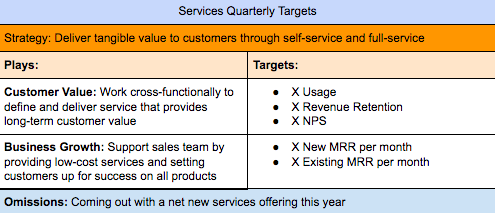From the customer's perspective, this handoff should be seamless. As soon as the sales process is complete, customers should be introduced to the resources they'll use when seeking help.
The best companies not only make customers feel confident about their purchase but in their relationship with the business moving forward.
In this post, let's break down HubSpot's process for improving the relationship between sales and service teams and what this looks like for our customers.
Sales to Service Handoff Process
1. Align sales and service management.
Sales and Customer Service leadership must be on the same page.
In fact, some companies believe this so much they’re blending the sales and service manager roles into one. This lets management align each team's functions, optimizing their performance.
When the leaders of different departments are regularly talking, they’re far less likely to set and chase conflicting goals.
It might seem simple, but if you’re a leader in the sales or customer success teams at your company, set up a weekly 1:1 to discuss top priorities. Hearing the other perspective will help you make decisions that'll benefit the entire company.
From the customer's end, this results in an efficient handoff process. When sales and service management is aligned, both teams know exactly what to do when acquiring new customers. Customers aren't waiting around for help and sales or service reps can answer questions about any part of the transition process.
2. Combine sales and customer success goals.
Customer success should consider the sales team’s targets, and sales targets must include the customer service team’s retention goals.
Sales could smooth-talk anyone into buying your product without considering customer fit. And yes, the customer success department could hit their retention goal if they refunded new customers who weren’t a perfect fit. But, neither scenario produces the best outcome for the customer for your business.
Instead, your company should use sales and service to nurture customers who are the best fit for your business. For example, here are some quarterly customer service targets we use at HubSpot. As you can see, both sales and customer service targets are represented.

With these goals, customers work closely with both sales and service teams. Once sales hands them off to service, customer success will onboard them to ensure they're needs are met.
If not, they can upsell or cross-sell an upgrade or additional product. This cycles the customer back to your sales team to repeat the process.
Under this system, customers become more comfortable with working with sales reps. The handoff between sales and service becomes more natural and customers are more trusting of your agents.
That's because you're referring them to sales when they actually need your products, not because you want to make a quick buck.
3. Include the sales team in a customer success report card.
Sales reps are focused on bringing in new business for the company. That unwavering dedication makes them successful. But, it can also cause them to lose sight of retaining customers as well.
Getting sales more invested in customer retention is relatively simple -- just keep them in the loop on the customer success team’s progress and playbook. This also helps them speak knowledgeably about the customer service hand-off once they've closed a new customer.
Sales reps are notoriously guarded with their time, so be sure to choose the right medium for this update. Since they spend most of their day in their inbox, my team chose email because weekly emails are easy to read and digest.
When sales teams focus more on customer retention, it's easier to identify high-value leads. While they may pursue fewer prospects, sales reps will have more time to pitch leads who are the best fit for your business. And, these customers can produce five times more revenue than your average customer.
4. Create a buddy system.
This one might sound borrowed from your kindergarten curriculum, but trust me -- it improves the sales to service handoff immensely.
Sales reps like having a customer success representative they can talk to and trust. So give them one. This relationship humanizes both departments and gives the customer services representative an opportunity to teach (and if your services team is like mine, they like that).
At our company, we create Google Slide decks of updates for the sales team. These give sales reps the opportunity to ask questions, and the customer success team gets valuable insights on the handoff and other collaborative efforts from the sales reps.
Disclaimer: The customer service team did have to buy the sales team lunch to steal their time without complaints.
When sales and service teams are familiar with each other, customers get quicker answers. If customers have service questions during the sales process, the sales agent will have someone to refer them to.
And, vice-versa. if customers have questions about new products or upgrades, service reps will know exactly where to direct them.
5. Leverage the @mention in the handoff process.
If you use a CRM, you know what the @mention is. If you don’t use a CRM, you should be using one to manage your customer relationships. (Hint: We offer free CRM software here at HubSpot).
Typing @mention [name] while on a customer’s contact record in the CRM will tag the appropriate sales or services rep. They’ll get an email notification with your comment.
This is a quick and easy way to get a rep’s attention and keep them connected with the customer experience -- even after the close. Here are my team’s most common uses of @mention:
- When the services rep gets extra information from the sales rep about the customer before the first onboarding call
- If either the sales or service reps celebrate a customer win or upgrade opportunity
- When the sales rep is checking in on how a high-value customer is doing
This provides customers with timely solutions. Your team doesn't have to wait to ping a sales rep and explain the situation. Rather, your sales agent will be notified immediately and can quickly step in to capitalize on the opportunity.
Pro tip: Don’t let the @mention take the place of walking over to a sales rep’s desk. Make sure both teams are getting face-to-face time, too.
There’s No ‘I’ in Customer Success
Many customer success teams believe improving the customer experience is limited to the customers who purchase. But the more you collaborate with Sales before the purchase, the better the customer handoff will be -- and the less support you’ll need for problems down the line.
A version of this blog post originally appeared on LinkedIn.
Customer Onboarding








![10 Customer Onboarding Challenges You Might Face This Year [+Expert Tips]](https://53.fs1.hubspotusercontent-na1.net/hubfs/53/ai%20customer%20service%20predictions%20(2).webp)

![Digital Onboarding: How to Make It Work For You [+ 5 Helpful Tools]](https://53.fs1.hubspotusercontent-na1.net/hubfs/53/digital%20onboarding_featured%20image.jpg)
![Perfect Your Customer Onboarding With Our Expert Tips [Easy Guide + Checklist]](https://53.fs1.hubspotusercontent-na1.net/hubfs/53/onboard.webp)
.webp)